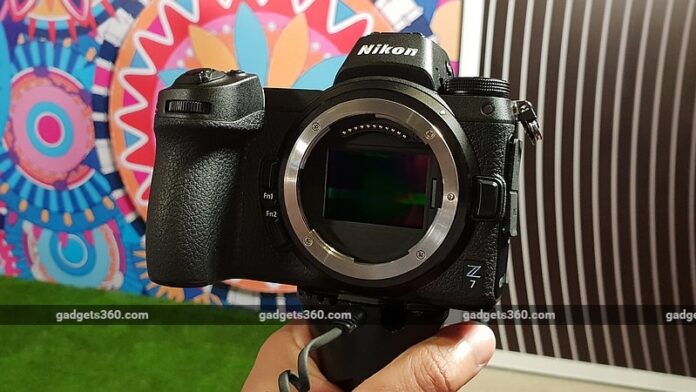Nikon on Wednesday launched its recently unveiled Nikon Z7 and Nikon Z6 full-frame mirrorless cameras, the first such offerings for the company. Taking on Sony in the segment, Nikon also launched its new Nikkor Z series lenses in the country, featuring a new larger diameter mount. The two cameras, one high-end and one mid-range, are physically identical, but differ in terms of megapixels, focus points, and ISO range.
The Nikon Z7 and the new range of Nikkor Z lenses will go on sale in India from September 27, while the Nikon Z6 will go on sale from November. The Nikon Z7 body-only price has been set at Rs. 2,69,950, while the Nikkor Z 24-70mm F/4 S + Mount Adapter FTZ Kit will cost Rs. 3,26,950, the Nikkor Z 24-70mm F/4 S Kit will cost Rs. 3,14,950, and the Nikon Z7 + Mount Adapter FTZ Kit will cost Rs. 2,81,950.
The Nikon Z6 body-only has been given a price tag of Rs. 1,69,950, while the Nikon Z6 + Nikkor Z 24-70mm F/4 S + Mount Adapter FTZ Kit is priced at Rs. 2,26,950, the Nikon Z6 with Nikkor Z 24-70mm F/4 S Kit is priced at Rs. 2,14,950, and the Nikon Z6 + Z6 Mount Adapter FTZ Kit is priced at Rs. 1,81,950.
As for the standalone prices of the lenses and mount adapter, the Nikkor Z 24-70mm F/4 S is priced at Rs. 78,450, the Nikkor Z 35mm f/1.8 S is priced at Rs. 66,950, the Mount Adapter FTZ is priced at Rs. 19,950, and the Nikkor Z 50mm f/1.8 S is priced at Rs. 50,950.
At the New Delhi launch event, Nikon India MD Sajjan Kumar said that company is looking to have its DSLR and mirrorless lineups co-exist. In terms of specifications, both the Nikon Z7 and Z6 come with a backside illuminated CMOS sensor, with focal-plane phase-detection AF pixels. The Z7 features a 45.7-megapixel sensor and supports the ISO 64-25600 range of standard sensitivities. However, reduction to the equivalent of ISO 32 and expansion to the equivalent of ISO 102400 is also possible. Meanwhile, the Nikon Z6 has a 24.5-megapixel sensor, and supports an ISO range of 100-51200, including an additional reduction to the equivalent of ISO 50 and expansion to the equivalent of ISO 204800.
Notably, the Nikon Z7 has 493 focus points and the Nikon Z6 has 273 focus points, covering 90 percent of the imaging area both horizontally and vertically. The company says that the hybrid autofocus system uses an algorithm optimised for the FX-format sensor, and automatically switches between focal-plane phase-detection AF and contrast-detect AF to achieve focus.
The Nikon Z7 and Z6 come with a new Expeed 6 image-processing engine. The mid-range sharpening option has been added to Picture Control sharpness parameters. Also, the cameras offer 20 options of Creative Picture Control, supporting creative imaging expression. The effect level is adjustable from 0 to 100.
Both the Nikon Z7 and Z6 come with an electronic viewfinder for which a roughly 3690k-dot OLED panel has been adopted. Nikon says that the electronic viewfinder has frame coverage and magnification of approximately 100 percent and 0.8 times, and approximately 37.0-degree diagonal viewing angle.
Meanwhile, a fluorine coating that effectively repels dirt has been applied to the eyepiece protection window. Addition, the menu can be displayed in the electronic viewfinder, allowing users to quickly view and adjust a variety of shooting settings, including ISO sensitivity, AF-area mode, and Picture Control, all while looking through the viewfinder, the company said.
The Nikon Z7 and Z6 provide in-body image stabilization or vibration reduction that claims up to 5 stops efficiency with native Nikon Z lenses and 3 stops with adapted Nikon F lenses. Both the Nikon Z7 and Z6 can capture 10-bit 4:2:2 3840×2160 pixels 4K video at 24, 25, and 30 fps.
Now we get to the three new lenses – the standard zoom Nikkor Z 24-70mm f/4 S, the wide-angle prime Nikkor Z 35mm f/1.8 S, and the standard prime Nikkor Z 50mm f/1.8 S. They are equipped with functions that include: compensation for focus breathing (the shifting of the angle of view when the focus is adjusted), quiet operation, smooth exposure control, a control ring, and performance that are all well suited to movie recording.


